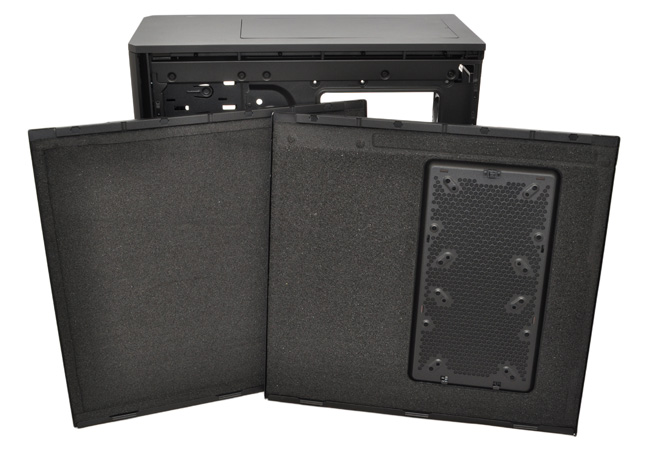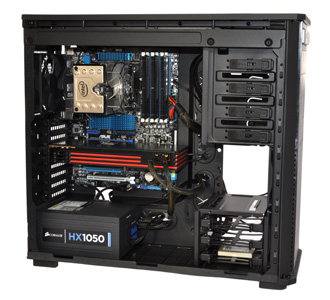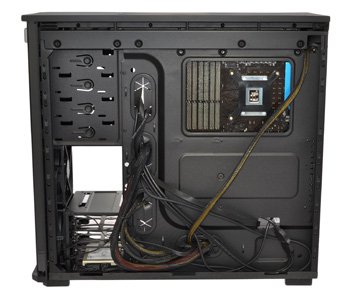Inside the Obsidian Series 550D

As soon as the build process gets off and running, you begin to appreciate the builder-friendly features that the 550D has to offer.
In addition to the quick-release side panels, the chassis has all the basics covered - including an all-black interior (with black fixtures and fittings), tool-free optical bays, hard-disk bays that support both 2.5in and 3.5in disks, plenty of cable-routing holes, a large cutout in the motherboard tray, thumb-screwed PCI expansion slots, and enough room to house plenty of high-end hardware.
Micro-ATX and ATX motherboards are supported, and the specification is in line with what you'd expect from a case that costs over £100. There are four 5.25in optical bays, six 2.5/3.5in storage bays split across two cages, four rubber-grommeted cable-routing holes, eight expansion slots, a good amount of room behind the motherboard tray for storing excess cabling, and enough room above most standard ATX motherboards to install a 240mm radiator.
The well-stocked feature list is no surprise, but Corsair's attention to detail is what makes the 550D stand out against the company's own previous solutions. The pre-installed fans and storage bays, for example, have silicone mounts to help prevent vibration, and the bottom-corner PSU mount features rubber standoffs and padding that sits between the PSU and the 550D's steel frame. There's also enough room to squeeze in a large PSU and a bottom-mounted fan, and a pull-out dust filter covers both on the underside of the chassis.
The roomy interior is hard to fault. Corsair's cable-routing holes are well positioned and the rubber grommets don't slip out too easily, there are cutouts above and below the motherboard tray for those awkward-to-route cables, all three fans use standard three-pin headers, and though the front USB 3.0 ports are designed to be connected to an on-board header, Corsair includes a USB 3.0-to-USB 2.0 adaptor as part of the bundle. Even the storage bays are clever - they feature a central mount for 2.5in disks, so users installing SSDs needn't fumble around trying to remove the silicone 3.5in mounts on the sides.
There's nothing particularly extraordinary here, but whoever designed the 550D appears to know what makes a chassis really easy to work with. We didn't hit any stumbling blocks or awkward moments when building into the chassis, and our X58 test machine was put together with consummate ease.
As pictured above, the top storage cage can be removed to make way for graphics cards measuring up to 452mm in length, but few users will feel the need as the 550D is more than deep enough for most cards on the market today. The pictured Radeon HD 6970 fits in with ample room to spare.
Building into the 550D is an absolute breeze, but now onto the most important part; how well does the soundproofing work? Are the various sound-deadening elements enough to make the 550D near silent in use, and will it have an adverse effect on temperature? Read on for all the answers.













